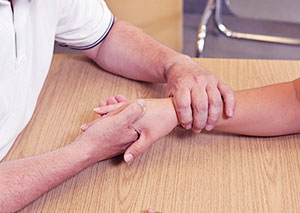
Hand and Wrist Conditions
The hand is one of the most flexible and useful parts of our body that enable us to perform many of our daily activities. The hands and wrists are prone to injuries or certain orthopedic conditions and can range from minor cuts or burns to severe arthritis or injuries of nerves, bones, and tendons.
The hand and wrist conditions that can be treated non-surgically include:
- Dislocated fingers or wrist
- Hand nerve injuries
- Arthritis
- Carpal tunnel or cubital tunnel syndrome
- Tendon injuries
- Tumors and cysts
- Trauma
- Dupuytren's contracture
- De Quervain syndrome
Non-surgical Treatment Options
Non-surgical treatment options for the hand and wrist include:
Rest, Ice, Compression, and Elevation (R.I.C.E.)
This is the most commonly suggested treatment option. Staying off (resting) the injured hand and wrist can help heal the condition. Covering the affected area with ice packs over a towel reduces swelling and pain. Compression stockings or elastic bandages and elevation helps to keep the swelling down.
Medications
Prescribed non-steroidal anti-inflammatory drugs (NSAIDs) and/or opioids may be recommended for the management of pain and inflammation.
Dry Needling
This option involves the use of thin, dry needles to stimulate trigger points and increase blood circulation to the muscles of your hand. Your skin is punctured with thin needles to provide relief from pain and offer other therapeutic benefits. Dry needling techniques are often combined with other non-surgical methods to relieve pain.
Immobilization
Casts and splints are used to immobilize your fractured hand and wrist. Your doctor may suggest splints immediately after an injury to reduce inflammation. Once the swelling goes down, casting may be necessary to protect the fractured or injured bones.
Massage
Massage is the skilled manipulation of soft tissue and muscles with the fingers and hands. It involves the application of pressure to relax the muscles and increase blood circulation. Oils and lotions may be used during a massage. Massage therapy is found to be beneficial to those suffering from arthritis.
Physical Therapy
Physical therapy may be recommended to improve range of motion, flexibility and strengthen the hand and wrist muscles. Your hand therapist works closely with your doctor and teaches you various physical therapy exercises.
Steroid Injections
A mixture of steroid and anesthetic is injected into the joints of your hand to reduce pain and inflammation. It is used to treat hand and wrist conditions such as carpal tunnel syndrome, arthritis, trigger finger, tennis elbow, and tendonitis.
Transcutaneous Electrical Nerve Stimulation (TENS)
TENS uses small, electrode patches that are placed on the skin of your hand. The electrodes are connected to a battery-operated device (TENS unit) that delivers electric signals to the nerves of your hand. TENS stimulates your nerve fibers and reduces pain signals to your brain to help relieve arthritic pain. It also may stimulate your brain to release hormones called endorphins (chemicals that reduce pain).















